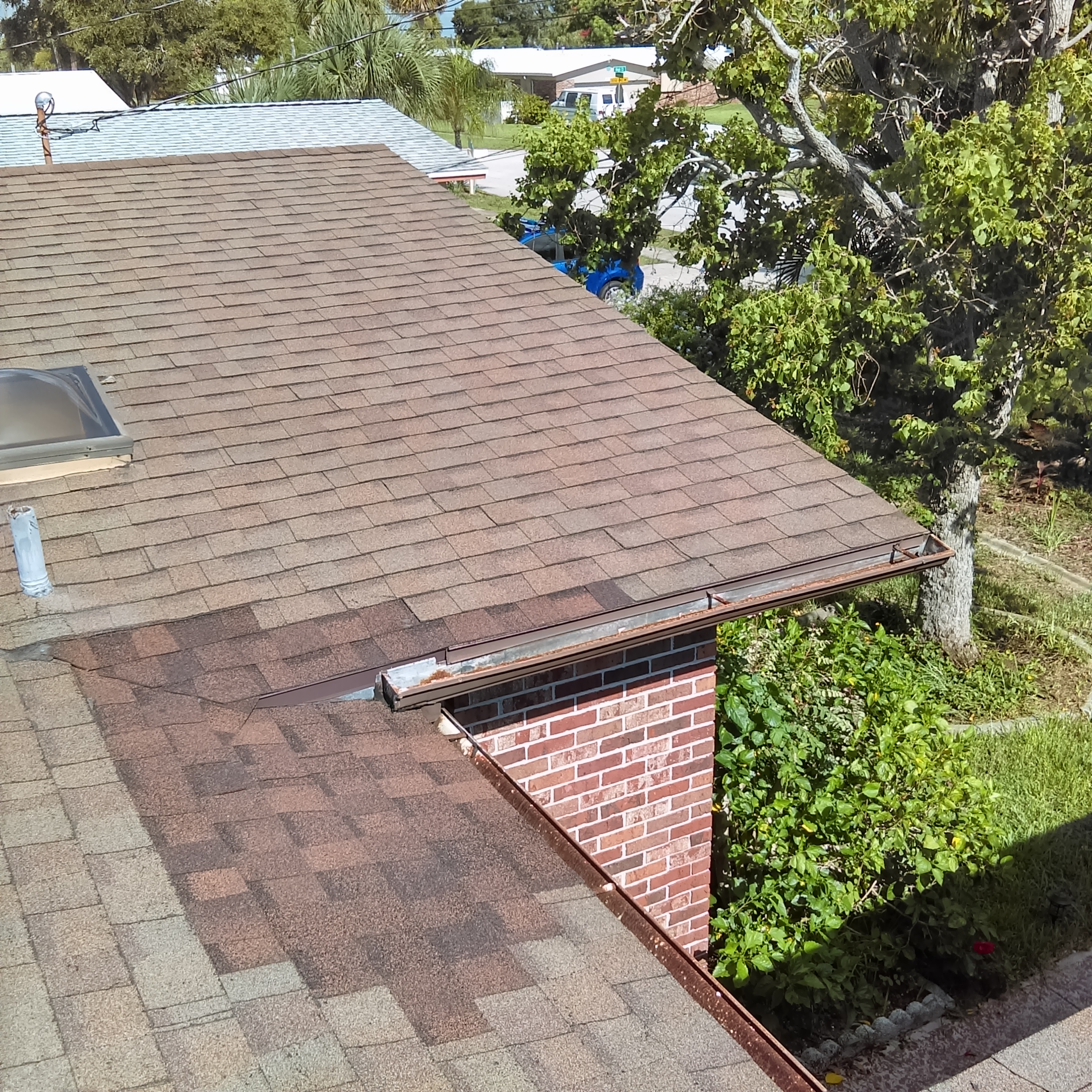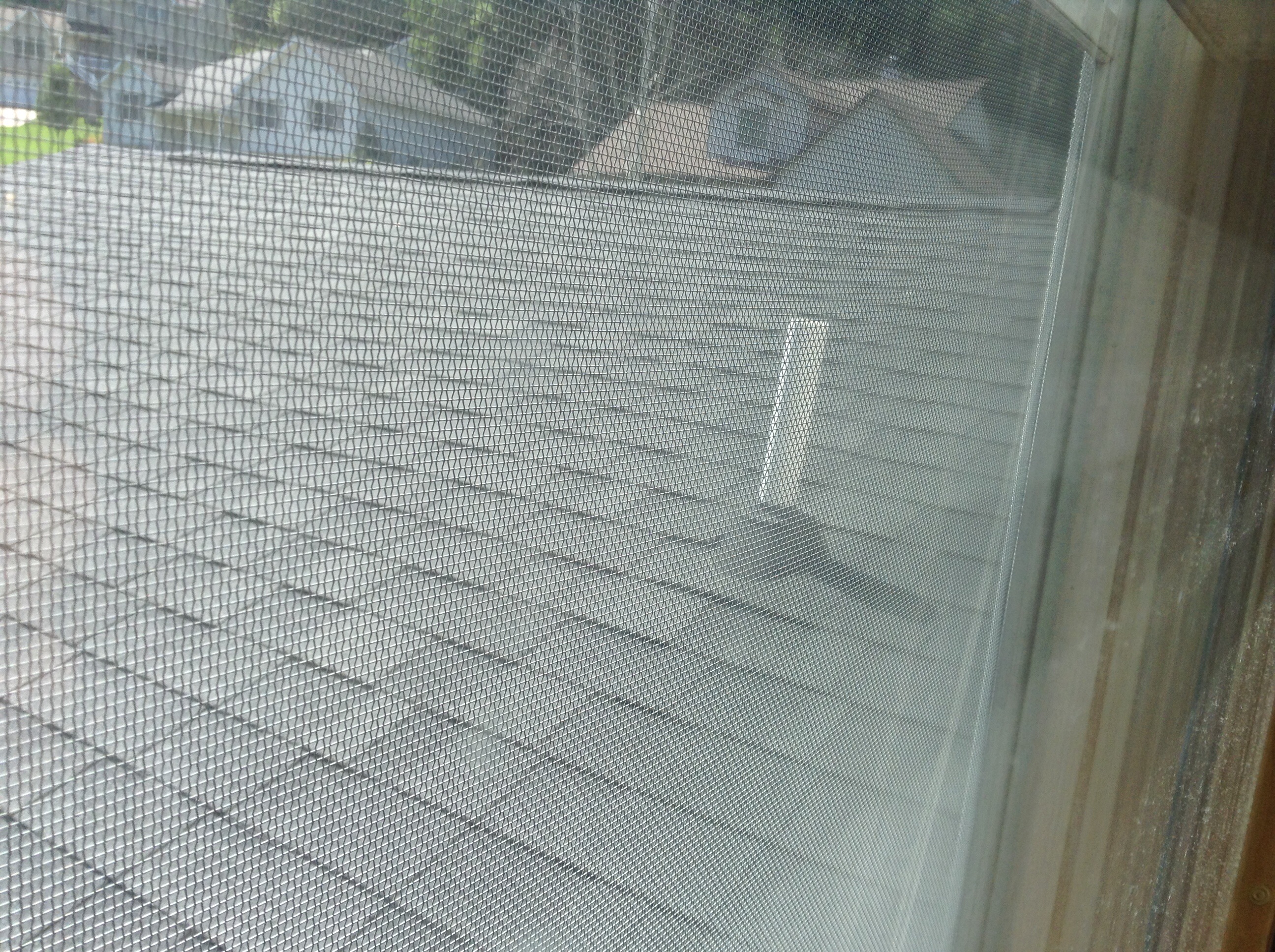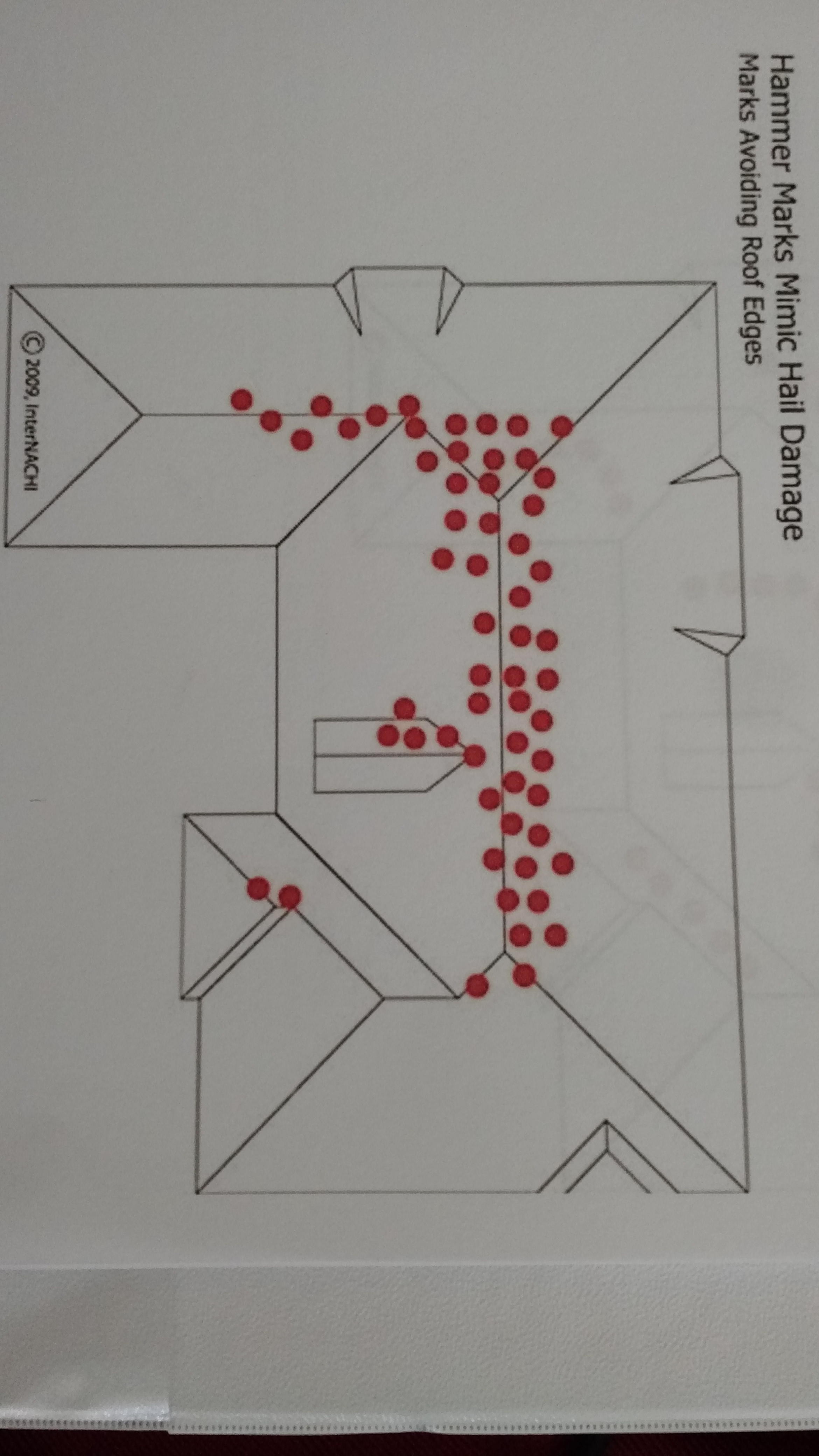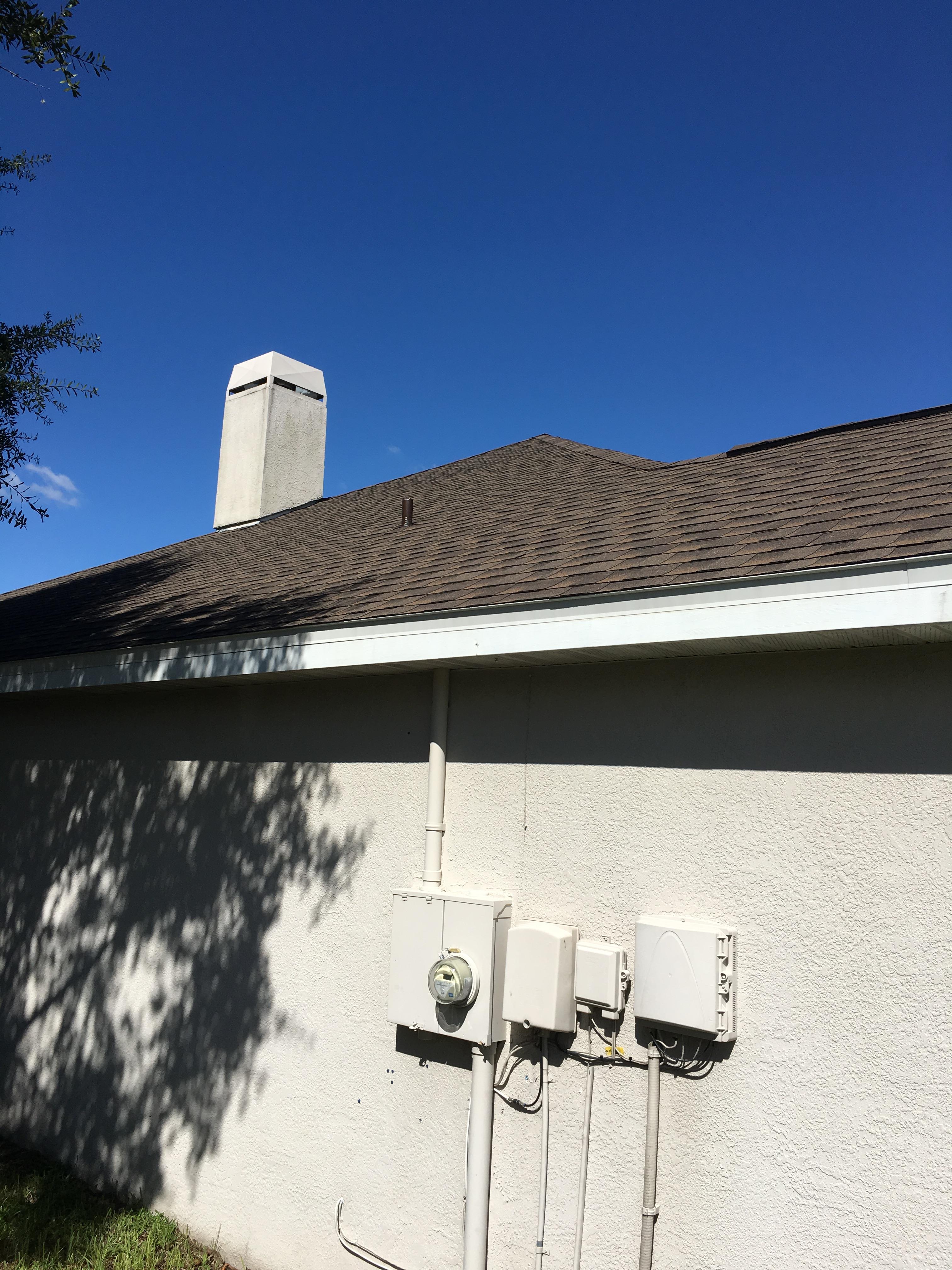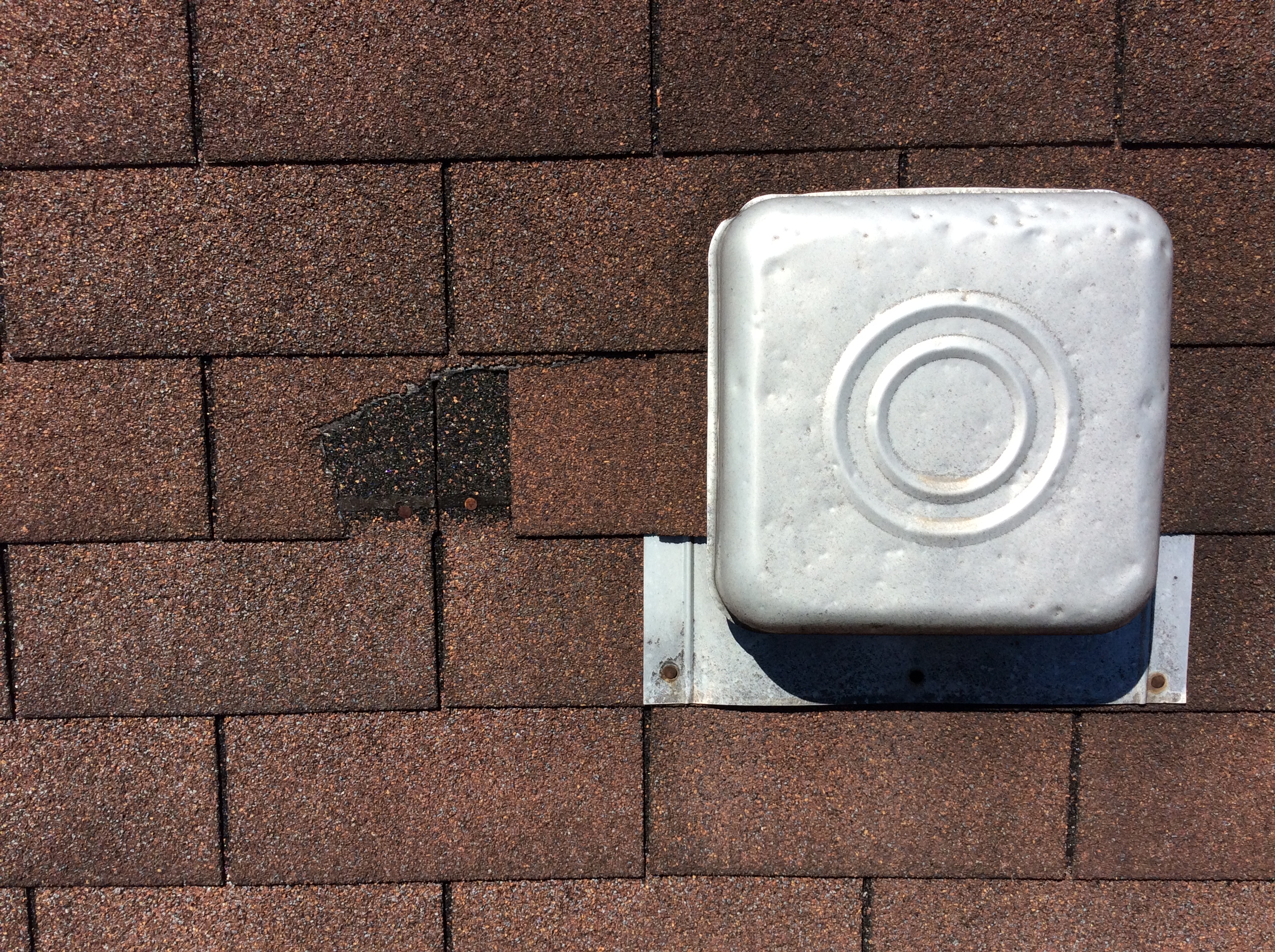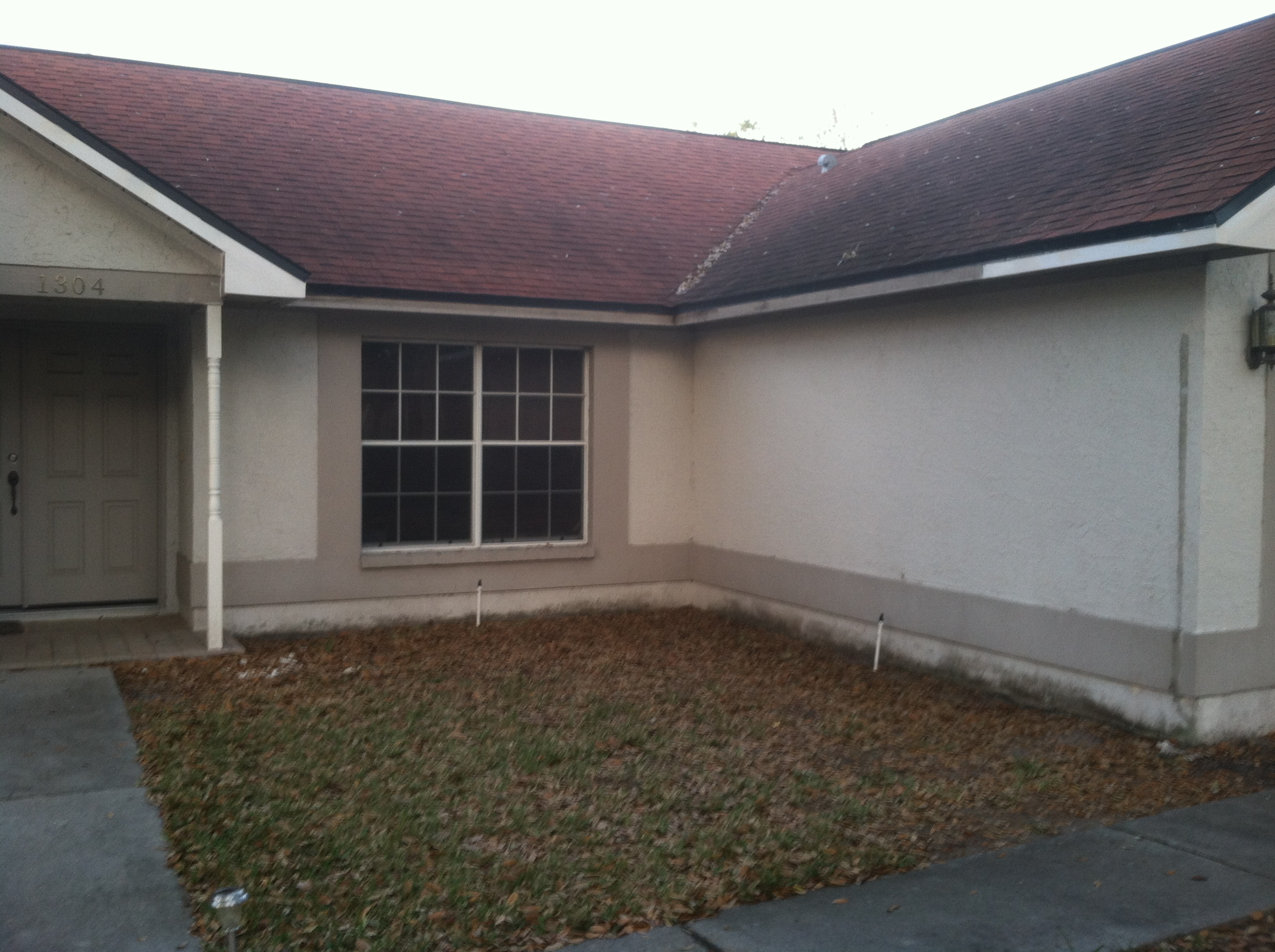This is a photograph of an asphalt shingle roof. There is a previous repair, indicated by the patch of shingles in a different color. This is also an area of concern because valleys and conjunctions of two different roof plains are more susceptible to water damage. The gutter system also shows significant rusting and should be monitored.
Organic shingles are more prone to distortions towards the end of its life cycle. As volatiles dissipate the shingle becomes more absorbent to water and expand. As the shingle expands and contracts it tends to delaminate and compromise the effectiveness of the shingle.

Asphalt shingled roofs may become damaged during their lifetimes by things other than naturally occurring circumstances. Some of these include scuffing and marring from being traversed. Other examples my be from tool damage or impact damage from objects falling down.
The attached photo is of improper installation of a roof boot on a home with dimensional shingles. The lower flange of the roof boot should be on top of the shingles and this one is shingled over and possibly allowing eater intrusion.
I chose a photo of proper shingle fastening as it pertained to this course. In most areas the four nail pattern is sufficient but in wind prone areas, the six nail pattern is recommended or even code. In most cases, unless the shingle bond is broken, you cannot see the pattern used.
With respect to Intentional Hail Damage, a property inspector should be aware that if there is hail damage, be cautious; the damage may not have been caused by natural sources. It may in fact possibly be caused by intentional damage and the use of a different device to replicate hail damage. Knowing what to look for, between intentional damage and natural damage is important. Be careful to know how the damage occurred; naturally or intentionally.
I selected the article “Mastering Roof Inspections: Hail Damage, Part 1”, by Kenton Shepard and Nick Gromicko. As discussed in the article, Hail can be a nightmare for a homeowner and a nemesis for a home inspector when having to determine if the real cause was natural or intentional, and very costly for the insurance industry. The take away, it is important for the property inspector to know the variables.
The picture is of a roof just two months after being re-shingled due to high-wind damage over 2/3s of the covered roof area.
My findings: The materials are dimensional asphalt shingles, a shrink-wrap underlayment, and a four-ply plywood roof deck. Each shingle has 6 roofing nails fastening it to the roof structure. There are no old shingles or old underlayment present. A starter strip is present under the first run of shingles. The drip-edge flashing along the eve is under the underlayment, and the drip-edge flashing along the rakes are placed over the underlayment material. All shingles, to include the shaded areas, have bonded very well. Chimney flashing is new, and the plumbing air-vent is covered with a new lead sleeve. All ridge-cap shingles are hand-sealed, and the ridge-vents are properly installed. No gutter system is present on this roof system.
Suggestion: Adding a gutter system to this roof eve would greatly improve the run-off of rainfall away from the buildings foundation.
The photo I uploaded would be marked as a defect as you can see the nail heads are exposed. When the nails are exposed like this water can trickle down along the nail shaft causing damage to the decking into the attic.

The image I looked at was “Asphalt Shingle Nailing Diagram”. What I learned is how a properly driven nail should look like and what can be the result of an improper driven nail. If a nail is driven at an angle it will not anchor right and with enough wind can cause the shingle to fail.
H-Clips for Inspectors by Nick Gromicko and Kenton Shepard
What I learned from the article in regard to the actual clips:
H-clips are small steel devices that are slipped between sheathing panels at the time of construction. They bind adjacent panels together, and distribute heavy weight and pressure throughout the roof decking.
Their size must match the thickness of the sheathing panels.
Using them may lower building costs, i.e., possibly less rafters at a wider distance apart, and the option to use thinner roof sheathing panels.
They may cause buckling or warping of the sheathing when used due to normal expansion and contraction of the panels.
In regard to required verses not required:
The 2006 International Residential Code (IRC) requires H-clips in construction, but not all code jurisdictions will comply with the directive. Which brings me to a very important lesson to adhere to; and that is this; and I quote, Since InterNACHI standards of practice are limited to safety and system defects, it is not necessary for inspectors to determine whether a lack of H-clips constitutes a code violation. Plus, I should not become encumbered by various code requirements. Although, I would note the lack of H-clips in my inspection report as a defect if construction plans required them, or that I know for a fact that at the time of construction they were required. Either way, I will always note the absence of H-clips in my reports.
I chose a picture of a roof with asphalt shingles. These shingles are 3 tab and look to be installed with the step method. The combustion stack is correctly flashed. Vents are installed at the top of the roof to help circulate the air in the attic.
I chose the hail damage picture. Characteristics of hail damage usually are sporadic on the roof in which the granuals will still be shown. Hail damage cause splits in the asphalt shingle which starts at the bottom and goes through the mat to the top of the shingle causing leaks.
Performed a roof inspection and found numerous problems.The uploaded picture shows a damaged asphalt roofing shingle. There was also gutters that were clogged up with leaves and debris because there were large tree limbs hovering over the roof of the house.
Deck components: Each component of a wood deck are very important. The most important component of a deck is the footing and posts that support the deck. If these two components are not designed and installed correctly, there is a possibility that the deck could collapse over time.
Fiberglass asphalt roof estimated at 10 years old. Two large oak trees over hanging on to roof. Black roof stains from trees present at time of inspection. Accumulation of leaves present in all valleys of roof. Suggest regular maintenance of leave removal. Dryer exhaust vent present and functional at time of inspection. Drip edge present and functional.
Laminate Floor Inspection
Laminate floorings resemble natural materials. Manufactures require having a vapor barrier and expansion gaps. Laminated flooring is more affordable than hardwood flooring. Laminated floorings cannot be sanded and refinished like hardwood floors. Laminated flooring are not immune to a variety of defects.
This is an image of an ice dam on a roof. Ice dams form when snow melts, runs down the roof and refreezes near the edge. This occurs because part of the upper roof is warm and the eaves are cold. Ice dams can cause roof leakage not only by the ice but by someone trying to remove the ice which can damage the shingles. A good way to prevent ice dams is to have a properly ventilated attic.

Here is a picture of a asphalt, cali-cut, architectural shingle roof. Here is a picture of a asphalt, cali-cut, architectural shingle roof. The Roof appears to be in perfect condition. I would say it is 1 to 5 years old.

I choose a picture from the chimney section in general, about the barometric damper. I study the picture and found how the parts fit together and the names of each one. Such as the damper open and closed and the exhaust flue.
